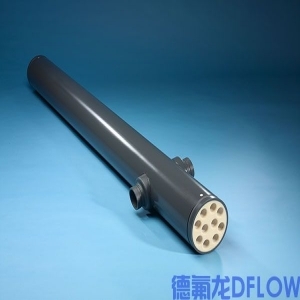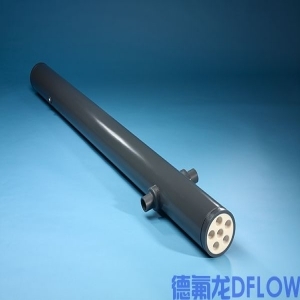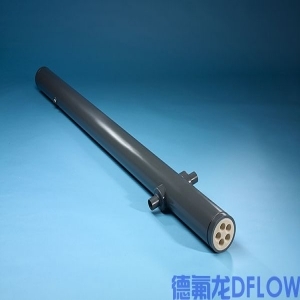好处
- 显着改善工厂安全
- 凝固点比氢氧化钠低
- 更快的沉淀絮凝物
- 更好地去除重金属和有机物
- 更好地脱水产生的污泥
- 不受 SARA Title III 监管
- 提高错流微滤系统的通量
- 减少对错流微滤系统的清洁要求
- 减少或消除额外的凝结剂
物理数据(典型)
气味:轻微
形态:浆液
冰点:32°F
RCRA 等级:非危险
DOT 等级:非管制,非危险
pH 38% 浆液:12.5/12.9 su
SARA RQ:无
DF-340 是一种独特的无害试剂,用于替代危险的氢氧化钠(苛性钠)溶液,用于中和许多工业 pH 值调节应用中的酸性废水。
由于我们独有的分散/稳定技术,DF-340 还消除了与使用石灰进行中和相关的历史成本和计量系统问题。
该产品由氢氧化钙与分散剂/稳定剂混合而成,可轻松制备浆液,其中氢氧化钙含量高达 38%(重量),可通过典型的化学品进料系统轻松计量。固体含量为 38% 的普通氢氧化钙/水混合物是一种“固体”,根本无法泵送。
石灰浆 - 氢氧化钠的常用替代品 - 提供较低的中和成本和各种化学益处。然而,由于与浆料补充和计量系统相关的成本和操作问题,这些历来仅用于最大的废水处理系统。
用 DF-340 代替烧碱将提供通常与石灰中和相关的好处,同时拥有成本低得多:
- 由于优异的混凝效果,可提高废水中重金属和有机物的去除率
- 形成更密集、更快沉降的絮凝体;和
- 形成更容易脱水的污泥。
与烧碱不同,DF-340 不是危险材料,不受 SARA Title III 的监管。因此,苛性碱替代品带来了巨大的监管效益,同时减少了健康和安全问题。
应用
DF-340 可用于中和任何不会回收或再利用的工业废水。典型的工艺设计包括添加任何初级沉淀剂或混凝剂,使用 DF-340 调节 pH 值(推荐剧烈混合),然后根据需要添加聚合物、沉淀和过滤。DF-340 的使用与大多数自动 pH 控制电路和系统兼容,因此可以轻松集成到现有的废水处理系统中。请联系 Duarflow 以获得详细的评估和设计帮助。
案例
马萨诸塞州的一家大型电镀加工车间最近用 DF-340 代替了烧碱。因为车间已经有一个合适的混合罐和混合器,所以转换的唯一费用是购买蠕动泵。这种转换的主要原因是环境 - 用非 SARA Title 材料替换 SARA Title III 危险材料。转换的结果非常好。该车间报告说,他们的流出物金属值降低了,产生的污泥更容易脱水。
第二个 DF-340 应用发生在同一家制造商完成了一个顺序批处理系统来处理来自铅水晶玻璃湿法整理的废水时。由于该公司希望在废水处理过程中不再使用任何 SARA Title III 材料,因此用 DF-340 代替了苛性钠(在原始设计中指定用于中和)。迄今为止的结果非常好。工厂排放的污水符合 pH 值和铅的排放标准,而产生的污泥很容易脱水成致密的滤饼。
- Faster settling floc
- Better removal of heavy metals and organics
- Better dewatering of produced sludge
- Not SARA Title III regulated
- Improved flux in crossflow microfiltration systems
- Reduced cleaning requirements for crossflow microfiltration systems
- Reduction or elimination of additional coagulants
Physical Data (Typical)
Odor: Slight
Form: Slurry
Freezing Point: 32°F
RCRA Class: Non-hazardous
DOT Class: Non-regulated, Non-hazardous
pH 38% slurry : 12.5/12.9 su
SARA RQ: none
DF-340 is a unique non-hazardous reagent developed to replace hazardous sodium hydroxide (caustic soda) solutions for neutralization of acidic wastewaters in many industrial pH adjustment applications.
Due to our exclusive dispersing/ stabilization technology, DF-340 also eliminates the historical cost and metering system problems associated with use of lime for neutralization.
The product consists of calcium hydroxide blended with dispersants/stabilizers that permit easy preparation of slurries, containing up to 38% by weight calcium hydroxide that can be easily metered via typical chemical feed systems. Normal calcium hydroxide/water mixtures at 38% solids are a "solid," which is not pumpable at all.
Lime slurries - a frequent alterative to sodium hydroxide - provide lower neutralization costs and various chemical benefits. However, these have historically been used in only the largest wastewater treatment systems due to the cost and operating problems associated with the slurry make-up and metering system.
Replacement of caustic soda with DF-340 will provide benefits normally associated with lime neutralization at much lower cost of ownership:
- Increased removal of heavy metals and organics from the wastewater due to superior coagulation
- Formation of a denser, faster to settle floc; and
- Formation of an easier to dewater sludge.
Unlike caustic soda, DF-340 is not a hazardous material and is not regulated under SARA Title III. Consequently, there are substantial regulatory benefits from caustic replacement as well as a decreased health and safety concerns.
Applications
DF-340 can be utilized for neutralization of any industrial wastewater that will not be recycled or reused. Typical process design would consist of adding any primary precipitants or coagulants, pH adjustment with DF-340 (vigorous mixing recommended), followed by polymer addition, sedimentation, and filtration, if needed. Use of DF-340 is compatible with most automatic pH control circuits and systems, and thus can be easily integrated into existing wastewater treatment systems. Please contact Duarflow for a detailed evaluation and design assistance.
Case History
A major plating job shop in Massachusetts recently replaced caustic soda with DF-340. Because the shop already had a suitable mix tank and mixer on-hand the only expense of the conversion was the purchase of a peristaltic feed pump. The major reason for this conversion was environmental - to replace a SARA Title III hazardous material, with a non-SARA Title material. Results of the conversion were excellent. The shop reports that their effluent metals values were lowered and that the produced sludge was easier to dewater.
A second DF-340 application occurred when this same manufacturer completed a sequential batch system to treat wastewater from wet finishing of lead crystal glass. Because the company wanted to eliminate use of any SARA Title III materials in the wastewater treatment process, it replaced the caustic soda (specified for neutralization in the original design) with DF-340. Results to date have been excellent. The plant discharge has complied with effluent standards for pH and lead, while the produced sludge is readily dewatered to a dense cake.







